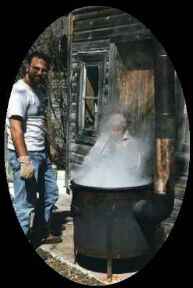MANITOBA MAPLE SYRUP
Maple Syrup is one of the oldest agriculture commodities in Canada. Sugar maple (Acer saccharum), which cannot be commonly grown on the prairies, is the species used for maple syrup production in Eastern Canada and Northern USA.
But, maple syrup is not limited to sugar maples. Manitoba maple (Acer negundo), which is also known as box elder, produces sap which can be boiled down to make an excellent tasting syrup. Manitoba maples are commonly found along riverbeds, in native woodlots, shelterbelts around farmyards and in communities as ornamental shade trees.
Manitoba maple trees should be at least 8 inches in diameter before they are tapped. Trees should be tapped in late February to early March to ensure the first flow of sap is collected.
To tap a tree, select a spot, at chest height, on the trunk in an area which contains sound wood that is void of knotholes or dead branches. Drill a 7/16 inch hole approximately 2 inches deep into the wood, slanting slightly upward to facilitate the flow of sap.
A tap (referred to as a spout, spile or spigot) is then inserted and tapped lightly into the predrilled hole. A bucket is then attached to the spout to collect the sap flow. Buckets should be covered to keep out debris. We use 2 gallon ice cream pails.
The sap flow from maple trees occurs on warm day following nights when the temperature drops below freezing. Sap flow does not occur every day and it can occur for as short a time as a few days or last up to 3 weeks or longer.
The sap should be collected and boiled down as soon as possible. If the sap is allowed to become too warm before boiling, a dark, off-flavored syrup will result. Sap collection should be discontinued when the buds on the tree start to swell. Once the tree starts to leaf out the sap acquires an off flavor known as a "buddy" flavor.
The process of making
maple syrup is essentially one of evaporating most of the water out of the sap
leaving behind the sugars and maple flavor. The amount of sap required to
produce one gallon of syrup depends on the sugar concentration. It usually takes
43 gallons of sap to produce one gallon of finished syrup.
Sap becomes syrup when the sugar concentration reaches 66 percent. It takes a full day to complete the process of boiling the sap to make syrup. Boiling should be done outside or in a well ventilated area to allow large amount of steam to escape. We do ours outside in an old 25 gallon Feed Cooker and do the finishing off on the burner of our BBQ. We find it is easier to control the temperature on the BBQ in the final stages when temperature is important. Once it reaches 219 degrees it is ready to put into sterilized bottles.
The average Manitoba maple will yield 15-20 gallons of sap in one season which amount to between 1/3 and 1/2 gallon of finished syrup per tree. Ultimately, syrup yields depend on the environmental conditions during the season.
As you can see, the process is not difficult, it is just very time consuming. I guess this would account for maple syrup being a bit pricey....but it is oh, so good! We enjoy being able to share ours with friends and family.